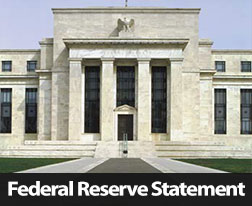The Federal Open Market Committee Holds Steady With Mortgage Backed Security Investments
 The Federal Open Market Committee (FOMC) of the Federal Reserve decided to continue its current policy of quantitative easing (QE) based on current economic conditions. The Fed currently purchases $40 billion in mortgage-backed securities (MBS) and $45 billion in Treasury securities monthly.
The Federal Open Market Committee (FOMC) of the Federal Reserve decided to continue its current policy of quantitative easing (QE) based on current economic conditions. The Fed currently purchases $40 billion in mortgage-backed securities (MBS) and $45 billion in Treasury securities monthly.
Objectives for the QE program include:
- Keeping long term interest rates, including mortgage rates, low
- Supporting mortgage markets
- Easing broader financial conditions
FOMC repeated its position of evaluating QE policy based on inflation, the unemployment rate and economic developments.
Members of the FOMC determined that keeping the federal funds rate between 0.00 and 0.25 percent until the following conditions are met:
- National unemployment rate reaches 6.50 percent
- Inflation is expected not to exceed 2.50 percent within the next one to two years
- Longer term inflation expectations are “well-anchored.”
Committee members agreed to consistently review labor market conditions, inflationary pressures and expected rates of inflation and other financial developments for determining their course of action on QE.
In its post-meeting statement, FOMC asserted that any changes to current QE policy would be taken in consideration of longer range goals for maximum employment and an inflation rate of 2.00 percent.
Fed Chairman Gives Press Conference
After the FOMC statement, Fed Chairman Ben Bernanke held a press conference which provided details about the future of QE and how the Fed will “normalize” its monetary policy. Chairman Bernanke noted that as QE is reduced and eventually stopped, the Fed will not be selling its MBS holdings.
This is important, as demand for MBS is connected to how mortgage rates perform. If the market is flooded with MBS, demand would slow, and prices would fall. When MBS prices fall, mortgage rates typically rise.
According to Chairman Bernanke, the FOMC does not see any immediate reason for changing its purchase of Treasury securities and MBS in the near term, but will continue to monitor conditions. Using the analogy of driving a car, the chairman indicated that the Fed’s intent regarding QE and the federal funds rate would be better compared to easing up on the accelerator rather than putting on the brakes.
Chairman Bernanke also characterized benchmarks cited in connection with increasing the federal funds rate as “thresholds, and not triggers.” This suggests that even if national unemployment and inflation reach Fed targets, that other economic conditions occurring at that time could cause the Fed to alter its plan for raising the federal funds rate.
The Fed chairman said that during Wednesday’s FOMC meeting, 14 of 19 participants did not expect changes to the federal funds rate until 2015, and one member didn’t expect a change until 2016.
Categories
- Around The Home
- Awards
- Bankruptcy History
- Budget
- Chapter 7 Bankruptcy
- Construction Loan
- Credit
- Credit Scoring
- Environmental Awareness
- Escrow Tips
- Fair Housing
- Federal Reserve
- FHFA
- Financial Crisis
- Financial Fraud
- Financial Reports
- Foreclosure
- Holiday Tips
- Holidays
- Home Building Tips
- Home Buyer Tips
- Home Buying Tips
- Home Care
- Home Care Tips
- Home Decorating
- Home Financing Tips
- Home Maintenance
- Home Mortgage
- Home Mortgage
- Home Mortgage Tips
- Home Mortgages
- Home Seller Tips
- Home Selling Tips
- Home Tips
- Home Values
- Home Values
- Homebuyer Tips
- Homeowner Tips
- Housing Analysis
- Housing Market
- Investment Properties
- Market Outlook
- Mortagage Tips
- Mortgage
- Mortgage Application
- Mortgage Guidelines
- Mortgage Rates
- Mortgage Tips
- mortgage-rates-whats-ahead-september-17-2012
- Organization Tips
- Personal Development
- Personal Finance
- Rankings
- Real Estate
- Real Estate Definitions
- Real Estate Tips
- Real Estate Trends
- Selling Your Home
- Student Loans
- Tax Debts
- Taxes
- The Economy
- Travel
- Uncategorized